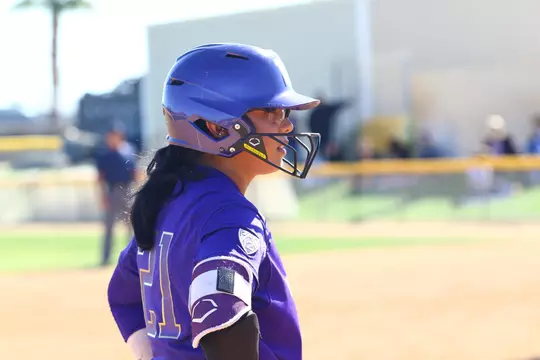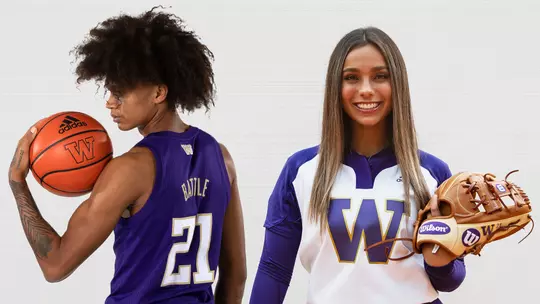
Native American Heritage Month
Kaelyn Sayles
11/27/2020
This Native American Heritage Day, Washington Athletics celebrates the Huskies with ties to their heritage during Native American Heritage Month.
RaeQuan Battle, a sophomore on the men’s basketball team, and SilentRain Espinoza, a junior on the softball team, have more in common than both being Washington student-athletes.
They also both share a deep tie with their Native American heritages. And both are excited to tell their stories.


The pride in their respective tribes runs deep.
Both grew up on reservations. Both were eager to teach about their cultures. To let people in so those unfamiliar can hear more about where they come from. To be representatives of their reservations that rarely – if ever – produced collegiate athletes.
HISTORY

Espinoza is a member of the Kumeyaay Indian Nation on the Viejas Reservation in Alpine, Calif., near San Diego.
Her dad’s family is Kumeyaay and her mom’s family is Penobscot, from Maine. Espinoza’s grandfather on her mom’s side moved to California when he was young and in the Marine Corps, so her mom grew up in San Diego.
“It’s been really nice growing up at the reservation because all my dad’s family lives all around us,” Espinoza said. “We’re a huge family, we’re all super close, and it’s awesome.”
Battle is a member of the Tulalip Tribes on the Tulalip Indian Reservation in Tulalip, Wash., near Marysville.
His grandmother on his mom’s side grew up in Oso, Wash. (northeast of Tulalip) in the Sauk-Suiattle Tribe. His grandfather is from Yakima, Wash. Eventually, they both migrated to Tulalip and the rest is history. Most of Battle’s extended family still lives there.
CULTURE
Battle has a close relationship with his mom Jacquie, who grew up Tulalip.
“My mom is full Native,” Battle said. “That’s why I grew up on the reservation…and I wear it to death.”
And Battle does wear it. His pride is on full display through the tattoos adorning his arms and leg.





The Lushootseed spelling of Tulalip (see below) is scrolled across one arm.
The Salish word means “small-mouthed bay,” which refers to the nearly landlocked nature of the cove.


On his other arm is Jacquie’s Indian name.
“My mom got her Indian name from the resemblance to my late great grandmother,” Battle said. “Her Indian name was also [see above for spelling], so they honored [my mom] with that because my mom loves to push our tribe. She loves to get our tribe out there, and that’s what my great grandma did.”

Battle said his great grandmother was a big part of the Tulalip culture.
“She helped save our Lushootseed language in the Northwest,” Battle said. “She has a whole album where she’s singing Native American songs on a loop four or five times so you can catch onto it.
“It’s not necessarily the words, it’s just the meaning behind the song. It’s the meaning of it, the noise in her harmonizing. I love to hear the sound of it.”
Battle carried on his family’s legacy of holding on to their culture.
In high school, he became frustrated while enrolled in other language courses because he wanted to learn the Coastal Salish language of the Tulalip tribe, Lushootseed.
“I’m trying to talk to our elders in our language,” Battle told one of the Native Liaisons at the school.
The year after he graduated, his school started offering Lushootseed.
“I’m happy for the kids that are going to go [there],” Battle said. “They’ll be able to learn that.”
Battle is thoughtful in the way he carries himself and is conscious of the way he appears to others. He said when he walks into the room, he feels as though people automatically assume he’s Black or mixed. So, he likes wearing things that show off his Native culture.
“I have these moccasins I might wear around, I have this cedar hat, I have a Native print for my shirts that I try to wear at appropriate times, just stuff like that,” Battle said.
He also has subtleties in his speech that only those familiar might pick up on: “A lot of Natives say ‘ehhh’ when they’re joking around, so I’ll do that around people to see if they’ll catch on,” Battle said with a grin.
While Battle is deeply rooted within his mom Jacquie’s Tulalip culture, Espinoza is more rooted within her father Greybuck’s Kumeyaay heritage.
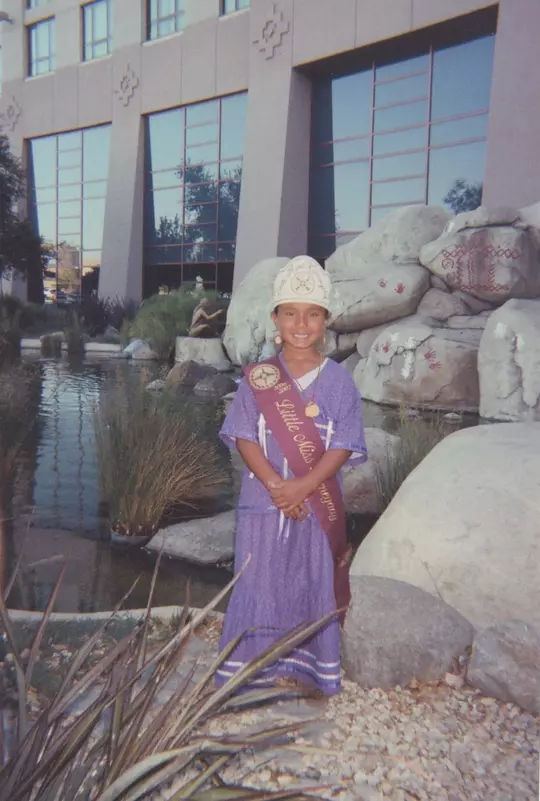
Espinoza vividly recalled growing up going to traditional gatherings during the summer on weekends. Everyone – even from different tribes – would come together for those gatherings.
“They do traditional dancing and singing and games,” Espinoza said. “I did traditional dancing all growing up my whole life and there’s this thing called pow wows. I was a pow wow dancer. I was a fancy shawl and jingle dancer.”
At age 12, Espinoza was the head young woman dancer for one of the pow wows.

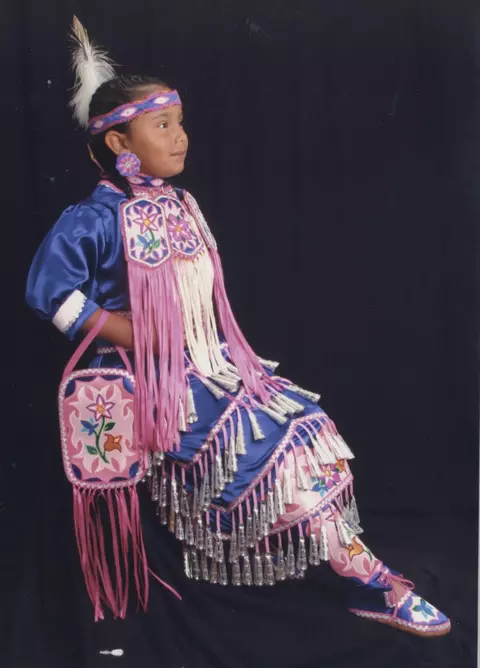
I really loved it and I loved just being around all the Native people. It was just a big family outside my immediate family...Everyone knew everyone.SilentRain Espinoza

PRIDE
Espinoza grew up playing in a league from her hometown where she was the only Native girl. As she got older and started playing on league teams in bigger cities, that distinction remained the same.
“When people would hear my name, they’d know I was something different, but they didn’t know what I was,” Espinoza said.

When people would hear my name, they’d know I was something different.SilentRain Espinoza
Greybuck was the one who came up with her name. She explained that in Native culture, rain is a symbol of healing and new life.
“He said that I came into the world in a quiet way, but I brought healing to my family, so that’s where I got SilentRain from,” Espinoza said.
Espinoza never had a hard time accepting her culture when she was growing up, but she did say it was difficult when she was younger to really express her pride in it.
She knew what her culture meant to her and her family. She knew she loved it. But she had a hard time talking about it because she knew it made her different.
That’s changed.
“As I’ve gotten older, I’ve realized that it’s a part of me that I would never want to change, that I’m very proud of now, and it’s what makes me, me,” Espinoza said. “It’s what makes me different, so I’d say I’m definitely proud of it. It shaped me into the person I am today.”
When she thinks back to those leagues she played on when she was younger, she’s struck by the memory of telling girls she’s Native American and in response hearing, “that’s awesome, I’ve never met a Native American.”
A train of thought escaped Espinoza as she thought out loud through that memory.
“Which is crazy I think because it’s so sad how Native girls are so underrepresented in a majority of sports, so I think for me, I really want to show all minority girls, specifically Native American girls, that it’s definitely possible that they can play at this level and succeed and get an education,” Espinoza said.
REPRESENTATION
It’s so sad how Native girls are so underrepresented in a majority of sports, so I think for me, I really want to show all minority girls, specifically Native American girls, that it’s definitely possible that they can play at this level and succeed and get an education.SilentRain Espinoza
Battle knows he is one of few Native Americans to make it to the level he’s at. But he’s also not counting anyone out.
“Native Americans aren’t known for being professional athletes, but every single one of them is an athlete,” Battle said. “You see somebody who doesn’t look like an athlete, but they’ll go out there and play basketball and hit a couple shots because it’s in them.”
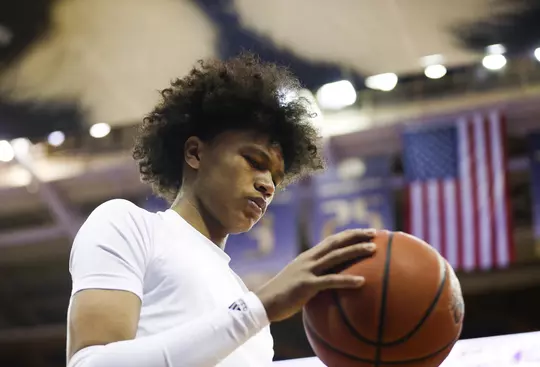

In Battle’s opinion, it’s not about being an athlete necessarily. Sure, talent is a big part of it. But opportunity is a whole other piece. A big piece.
He uses his mom as an example.
A basketball player in high school – who also wore 21 – Jacquie was called a “sparkplug” by coaches.
“But the people around her weren’t encouraging her to do that,” Battle said. “It wasn’t normal for a Native female to get an offer [to a DI school].”
So Battle presses on, not only for himself, but for his family, and to serve as an inspiration to his younger cousins.
Espinoza isn't the first in her family to play softball - after all, the softball field on the Viejas Reservation is named after her great grandfather Daniel Espinoza, who was a fastpitch softball pitcher - but she is the first in her family to not only play a college sport, but to go to a university.
She also believes she may be the first from her reservation to leave to play a college sport.
“It’s definitely a lot of pressure when I realize that I’m one of the only Native young women that’s made it this far in collegiate sports,” Espinoza said.

ROLE MODELS
Battle and Espinoza were both asked about what kind of advice they’d give to Native American kids wanting to pursue their dreams of playing college sports.
I just want them to push through any adversity that steps in front of them, no matter [what it is], you can find people who can help youRaeQuan Battle
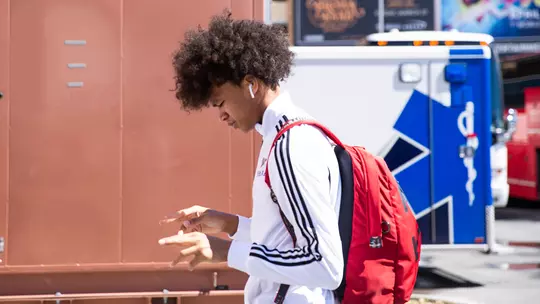
“Just figure out what’s important - what’s important to you and what’s important to your family.
“Figure out the direction you’re going to go, and figure out how you’re going to go about it. I don’t want kids to go about it the wrong way…I just want them to push through any adversity that steps in front of them, no matter whether it’s a loss in family, school, you can find people who can help you,” Battle said.
Looking for help when you’ve found yourself in a hole is something Battle continued to stress as he thought about his hope for Native kids.
He learned it because he’s lived it. And now he’s showing out in a Husky jersey.
“The [reservation] is different than any other ghetto. A lot of ghettos have talent coming out. They have singers, they have rappers, they have football players, they have people that do this, but the res has nobody that makes it out,” Battle said. “That’s why I’m working my hardest to put on for my city.”

Espinoza has also realized the role she has in inspiring Native kids. For her, that realization came during her freshman year.
After a home Husky game, the team was available to fans for an autograph session. Espinoza noticed a group of girls waving her over, so she went over to the group that included a mom with eight young girls.
That just put into perspective how doing what I love is making it possible and making it achievable for these young girls to see.SilentRain Espinoza

“They were all Native from a reservation here in Washington, and they were like, ‘we drove four hours to come watch you play. You’re such an inspiration to these girls,’ and that just put into perspective how doing what I love is making it possible and making it achievable for these young girls to see,” Espinoza said.
The smile she wore telling that story slowly settled into a more serious line.
The weight of the responsibility of being a role model.
“I guess I would just tell them that it’s possible to do anything,” Espinoza said. “I didn’t think I would be playing at one of the best softball colleges in the United States. I loved it, but I didn’t know how good I was, so I think just continuing to work hard and not give up, it’ll definitely be possible in the end.”
